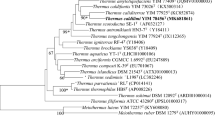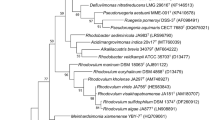Abstract
A Gram negative, yellow pigmented, rod shaped bacterium designated as RLT was isolated from a hot water spring (90–98 °C) located at Manikaran in Northern India. The isolate grows at 60–80 °C (optimum, 70 °C) and at pH 7.0–9.0 (optimum pH 7.2). Phylogenetic analysis of 16S rRNA gene sequences and levels of DNA–DNA relatedness together indicate that the new isolate represents a novel species of the genus Thermus with closest affinity to Thermus thermophilus HB8T (99.5 %) followed by Thermus arciformis (96.4 %). A comparative analysis of partial sequences of housekeeping genes (HKG) further revealed that strain RLT is a novel species belonging to the genus Thermus. The melting G+C content of strain RLT was calculated as 68.7 mol%. The DNA–DNA relatedness value of strain RLT with its nearest neighbours (>97 %) was found to be less than 70 % indicating that strain RLT represents a novel species of the genus Thermus. MK-8 was the predominant respiratory quinone. The presence of characteristic phospholipid and glycolipid further confirmed that strain RLT belongs to the genus Thermus. The predominant fatty acids of strain RLT were iso-C17:0 (23.67 %) and iso-C15:0 (24.50 %). The results obtained after DNA–DNA hybridization, biochemical and physiological tests clearly distinguished strain RLT from its closely related species. Thus, strain RLT represents a novel species of the genus Thermus for which the name Thermus parvatiensis is proposed (=DSM 21745T= MTCC 8932T).



Similar content being viewed by others
References
Brock TD, Freeze H (1969) Thermus aquaticus gen. n. and sp. n., a nonsporulating extreme thermophile. J Bacteriol 98:289–297
da Costa MS, Rainey FA, Nobre MF (2006) The genus Thermus and relatives. In: The prokaryotes: a handbook on the biology of bacteria, 3rd edn, vol 7. Springer, New York, pp 797–812
Hudson JA, MorganHW Daniel RM (1987) Thermus filiformis sp. nov., a filamentous caldoactive bacterium. Int J Syst Bacteriol 37:431–436. doi:10.1099/00207713-37-4-431
Kristjansson JK, Hjorleifsdottir S, Marteinsson V, Alfredsson GA (1994) Thermus scotoductus sp. nov., a pigment-producing thermophilic bacterium from hot tap water in Iceland and including Thermus sp. X-1. Syst Appl Microbiol 17:44–50. doi:10.1016/S0723-2020(11)80030-5
Oshima T, Imahori K (1974) Description of Thermus thermophilus (Yoshida and Oshima) comb. nov., a nonsporulating thermophilic bacteriumfrom a Japanese thermal spa. Int J Syst Bacteriol 24:102–112. doi:10.1099/00207713-24-1-102
Williams RAD, Smith KE, Welch SG, Micallef J (1996) Thermus oshimai sp. nov., isolated from hot springs in Portugal, Iceland, and the Azores and comment on the concept of a limited geographical distribution of Thermus species. Int J Syst Bacteriol 46:403–408. doi:10.1099/00207713-46-2-403
Williams RAD, Smith KE, Welch SG, Micallef J, Sharp RJ (1995) DNA relatedness of Thermus strains, description of Thermus brockianus sp. nov., and proposal to reestablish Thermus thermophilus (Oshima and Imahori). Int J Syst Bacteriol 45:495–499. doi:10.1099/00207713-45-3-495
Chung AP, Rainey FA, Valente M, Nobre MF, da Costa MS (2000) Thermus igniterrae sp. nov. and Thermus antranikianii sp. nov., two new species from Iceland. Int J Syst Evol Microbiol 50:209–217. doi:10.1099/00207713-50-1-209
Kurosawa N, Itoh YH, Itoh T (2005) Thermus kawarayensis sp. nov., a new member of the genus Thermus, isolated from Japanese hot springs. Extremophiles 9:81–84. doi:10.1007/s00792-004-0419-y
Bjornsdottir SH, Petursdottir SK, Hreggvidsson GO, Skirnisdottir S, Hjorleifsdottir S, Arnfinnsson J, Kristjansson JK (2009) Thermus islandicus sp. nov., a mixotrophic sulfuroxidizing bacterium isolated from the Torfajokull geothermal area. Int J Syst Evol Microbiol 59:2962–2966. doi:10.1099/ijs.0.007013-0
Zhang XQ, Ying Y, Ye Y, Xu XW, Zhu XF, Wu M (2010) Thermus arciformis sp. nov., a thermophilic species from a geothermal area. Int J Syst Evol Microbiol 60:834–839. doi:10.1099/ijs.0.007690-0
Vajna B, Kanizsai S, Kéki Z, Márialigeti K, Schumann P, Tóth EM (2012) Thermus composti sp. nov., isolated from oyster mushroom compost. Int J Syst Evol Microbiol 62:1486–1490. doi:10.1099/ijs.0.030866-0
Ming H, Yin YR, Li S, Nie GX, Yu TT, Zhou EM, Liu L, Dong L, Li WJ (2014) Thermus caliditerrae sp. nov., a novel thermophilic species isolated from a geothermal area. Int J Syst Evol Microbiol 64:650–656. doi:10.1099/ijs.0.056838-0
Prakash O, Verma M, Sharma P, Kumar M, Kumari K, Singh A, Kumari H, Jit S, Gupta SK, Khanna M, Lal R (2007) Polyphasic approach of bacterial classification—an overview of recent advances. Indian J Microbiol 47:98–108. doi:10.1007/s12088-007-0022-x
Altschul SF, Gish W, Miller W, Myers EW, Lipman DJ (1990) Basic local alignment search tool. J Mol Biol 215:403–410. doi:10.1016/S0022-2836(05)80360-2
Kim OS, Cho YJ, Lee K, Yoon SH, Kim M, Na H, Park SC, Jeon YS, Lee JH, Yi H, Won S, Chun J (2012) Introducing EzTaxon-e: a prokaryotic 16S rRNA Gene sequence database with phylotypes that represent uncultured species. Int J Syst Evol Microbiol 62:716–721. doi:10.1099/ijs.0.038075-0
Thompson JD, Gibson TJ, Plewniak F, Jeanmougin F, Higgins DG (1997) The CLUSTAL-X windows interface: flexible strategies for multiple sequence alignment aided by quality analysis tools. Nucleic Acids Res 25:4876–4882. doi:10.1093/nar/25.24.4876
Tamura K, Stecher G, Peterson D, Filipski A, Kumar S (2013) MEGA6: molecular evolutionary genetics analysis version 6.0. Mol Biol Evol 30:2725–2729. doi:10.1093/molbev/mst197
Jukes T, Cantor CR (1969) In: Munro HN (ed) Evolution of protein molecules in mammalian protein metabolism. Academic Press, New York, pp 21–132
Saitou N, Nei M (1987) The neighbour-joining method: a new method for reconstructing phylogenetic trees. Mol Biol Evol 4:406–425
Collins MD, Jones D (1980) Lipids in the classification and identification of coryneform bacteria containing peptidoglycan based on 2,4-diamino butyric acid (DAB). J Appl Bacteriol 48:459–470. doi:10.1111/j.1365-2672.1980.tb01036.x
Miller LT (1982) Single derivatization method for the routine analysis of whole-cell fatty acid methyl esters, including hydroxy acids. J Clin Microbiol 16:584–586
Kuykenkendall LD, Roy MA, O’Neil JJ, Devine TE (1988) Fatty acids, antibiotics resistance and deoxyribonucleic acid homology groups of Bradorhizobium japonicum. Int J Syst Bacteriol 38:358–361. doi:10.1099/00207713-38-4-358
Bligh EG, Dyer WJ (1959) A rapid method of total lipid extraction and purification. Can J Biochem Physiol 37:911–917. doi:10.1139/o59-099
McCarthy AJ, Cross T (1984) A taxonomic study of Thermomonospora and other monosporicactinomycetes. J Gen Microbiol 130:5–25. doi:10.1099/00221287-130-1-5
Arden-Jones MP, McCarthy AJ, Cross T (1979) Taxonomic and serological studies on Micropolyspora faeni and Micropolyspora strains from soil bearing the specific epithet rectivirgula. J Gen Microbiol 115:343–354. doi:10.1099/00221287-115-2-343
Dwivedi V, Sangwan N, Nigam A, Garg N, Niharika N, Khurana P, Khurana JP, Lal R (2012) Draft genome sequence of Thermus sp. RL isolated from hot water spring located atop the Himalayan Ranges at Manikaran, India. J Bacteriol 194:3534. doi:10.1128/JB.00604-12
Marmur J (1961) A procedure for the isolation of deoxyribonucleic acid from micro-organisms. J Mol Biol 3:208–218. doi:10.1016/S0022-2836(61)80047-8
De Ley J, Cattoir H, Reynaerts A (1970) The quantitative measurement of DNA hybridization from renaturation rates. Biochemistry 12:133–142. doi:10.1111/j.1432-1033.1970.tb00830.x
Kumar M, Verma M, Lal R (2008) Devosia chinhatensis sp. nov., isolated from Hexachlorocyclohexane (HCH) dump site in India. Int J Syst Evol Microbiol 58:861–865. doi:10.1099/ijs.0.65574-0
Tourova TP, Antonov AS (1987) Identification of microorganisms by rapid DNA–DNA hybridization. Methods Microbiol 19:333–355
Martens M, Dawyndt P, Coopman R, Gillis M, De Vos P, Willems A (2008) Advantages of multilocus sequence analysis for taxonomic studies: a case study using 10 housekeeping genes in the genus Ensifer (including former Sinorhizobium). Int J Syst Evol Microbiol 58:200–214. doi:10.1099/ijs.0.65392-0
Fox GE, Wisotzkey JD, Jurtshuk P Jr (1992) How close is close: 16S ribosomal RNA sequence identity may not be sufficient to guarantee species identity. Int J Syst Bacteriol 42:166–170. doi:10.1099/00207713-42-1-166
Jaspers E, Overmann J (2004) Ecological significance of microdiversity: identical 16S rRNA gene sequences can be found in bacteria with highly divergent genomes and ecophysiologies. Appl Environ Microbiol 70:4831–4839. doi:10.1128/AEM.70.8.4831-4839.2004
Sullivan JT, Eardly BD, van Berkum P, Ronson CW (1996) Four unnamed species of nonsymbiotic rhizobia isolated from the rhizosphere of Lotus corniculatus. Appl Environ Microbiol 62:2818–2825
Wayne LG, Brenner DJ, Colwell RR et al (1987) International Committee on Systematic Bacteriology. Report of the ad hoc committee on reconciliation of approaches to bacterial systematic. Int J Syst Evol Microbiol 37:463–464. doi:10.1099/00207713-37-4-463
Acknowledgments
This research was supported by funds from Department of Biotechnology (DBT), National Bureau of Agriculturally Important Microorganisms (NBAIM, ICAR), DU/DST-PURSE Grant, Government of India. KK, VD, SKG, RK, CT, PL, NN, AKS, RK, AN, NG gratefully acknowledge University Grants Commission (UGC), Council for Scientific and Industrial Research (CSIR), Department of Biotechnology (DBT) and Indian Council for Agricultural Research (ICAR) for providing research fellowships. We thank SAIF-DST (Sophisticated Analytical instrumentation Facility, Department of Science and Technology, Department of Anatomy, AIIMS) for providing the transmission electron facility. We also thank Dr. J. P. Euzeby (Ecole Nationale Veterinaire, Toulouse, France) for etymological advice.
Conflict of interest
The authors state that they have no conflict of interest.
Author information
Authors and Affiliations
Corresponding author
Additional information
Vatsala Dwivedi and Kirti Kumari have contributed equally to this work.
Sequence Deposited The GenBank accession number for 16S rRNA gene sequence of strain RLT (=MTCC 8932T= DSM 21745T) is EU017402.
Electronic supplementary material
Below is the link to the electronic supplementary material.
Rights and permissions
About this article
Cite this article
Dwivedi, V., Kumari, K., Gupta, S.K. et al. Thermus parvatiensis RLT sp. nov., Isolated from a Hot Water Spring, Located Atop the Himalayan Ranges at Manikaran, India. Indian J Microbiol 55, 357–365 (2015). https://doi.org/10.1007/s12088-015-0538-4
Received:
Accepted:
Published:
Issue Date:
DOI: https://doi.org/10.1007/s12088-015-0538-4




